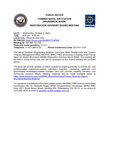




A fire suppression system malfunction at the former Brunswick Naval Air Station in Maine has released 51,450 gallons of firefighting foam and PFAS-contaminated water, underscoring the ongoing environmental challenges military installations face in managing legacy chemicals. This marks the second incident in two months, following a similar spill at Cannon Air Force Base in New Mexico.
On August 19, a mistaken trigger of a fire suppression system at a hangar leased to private entities resulted in the discharge of 1,450 gallons of aqueous film-forming foam (AFFF) and 50,000 gallons of water into nearby storm drains, sewer systems, and drainage ponds. This latest contamination event at the former Navy site, now part of Brunswick Executive Airport, comes as the Department of Defense (DoD) works to meet a looming deadline to eliminate AFFF from its operations.
Per- and polyfluoroalkyl substances (PFAS) are known for their persistence in the environment and accumulation in the human body. Linked to severe health risks, including testicular and kidney cancers, low birth weight, and other conditions, PFAS contamination has garnered increasing public and regulatory scrutiny.
Earlier this year, the Environmental Protection Agency (EPA) set new limits on acceptable levels of PFAS in drinking water due to mounting evidence of their toxicity, even at minuscule levels.
Although the Navy is not directly responsible for the recent spill, it is actively coordinating with the Midcoast Regional Redevelopment Authority (MRRA), which leases portions of the base and oversees cleanup efforts. According to David Bennett, public affairs officer for the Base Realignment and Closure Project Management Office, the Navy is working on a nationwide initiative to remove AFFF from systems located on Navy-owned properties, including leased sites.
The incident has reignited public concern in Brunswick, where residents and local leaders demand accountability. The Brunswick Town Council passed a resolution on September 3 calling for a full investigation into the spill and immediate action to disable PFAS-based fire suppression systems at remaining hangars. “This event is a public health and environmental catastrophe unlike any other our community has ever seen,” Brunswick Town Council Chairwoman Abby King stated in a letter to Maine Governor Janet Mills, pressing for answers and solutions.
This recent incident in Maine follows another PFAS-related spill at Cannon Air Force Base, where over 7,000 gallons of contaminated water were released in July. Both cases highlight the broader issue of PFAS contamination at military installations, where large inventories of AFFF have historically been used for fire suppression training and operations.
The fiscal 2020 National Defense Authorization Act mandated the phasing out of AFFF for training and operations by October 1, 2024, with exceptions for ocean-going vessels. In response, the military has been working to remove the foam from over 1,500 facilities and thousands of pieces of portable equipment. However, DoD officials acknowledged in July that they needed a one-year waiver to extend the deadline, citing the need for more time to eliminate AFFF from all installations and transition to alternative firefighting systems.
Despite these efforts, advocacy groups like the Environmental Working Group (EWG) remain concerned. "The DoD really needs to step up what they’ve been doing and make it a much bigger priority," said Jared Hayes, senior policy analyst at EWG. With over 700 active and former military sites under investigation for PFAS contamination, many communities across the U.S. are increasingly anxious about the potential risks to their health and environment.
The challenges of remediating legacy chemicals at active and former military bases are part of a broader environmental issue, as PFAS contaminates soil, water, and ecosystems nationwide. The growing legal and regulatory pressures facing industries responsible for PFAS contamination highlight the EPA's tightening restrictions and the increasing public demand for accountability.
The need for comprehensive cleanup strategies and accelerated removal of hazardous chemicals is becoming ever more urgent. The situation at Brunswick is yet another reminder of the enduring environmental legacies left by military operations and the importance of addressing them with urgency and transparency.
In the meantime, communities near affected installations continue to face uncertainty, hoping for faster action from military and government authorities to mitigate the risks of these “forever chemicals.”